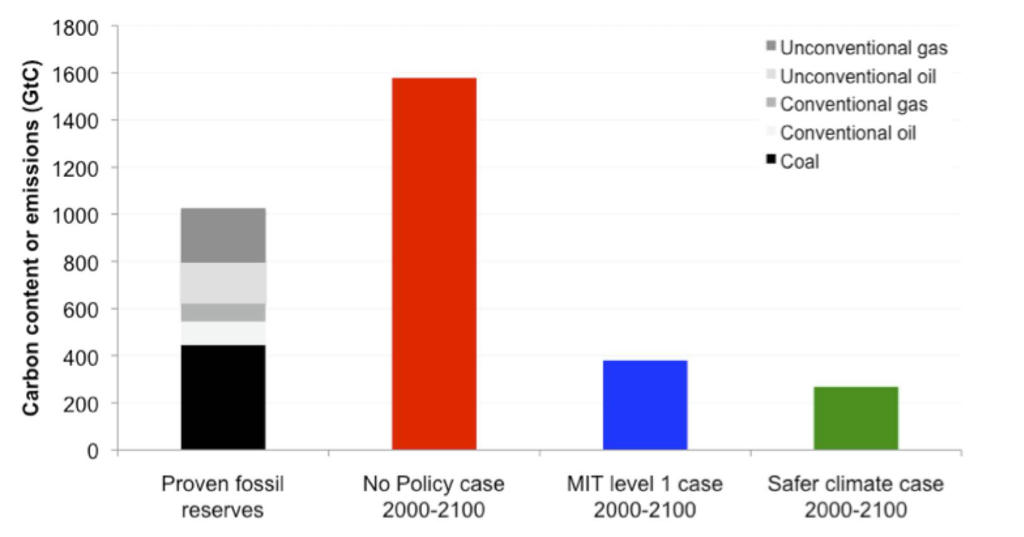Why fossil fuel abundance is an illusion
In a blog post published on April 12, 2012, Dan Lashof of NRDC makes it clear that we’ll run out of the earth’s ability to absorb greenhouse gases long before we run out of fossil fuels. In this blog post I’ll show why he’s exactly right.
In Cold Cash, Cool Climate, I explore this question quantitatively, using the latest fossil fuel resource estimates from IIASA’s Global Energy Assessment. To do that, I estimate lower bounds to global fossil fuel reserves and resources (which together make up what’s called the “resource base”, our best estimate of how many fossil fuel resources we have, not including exotic supplies like methane hydrates and other occurrences of hard to extract deposits). Reserves are well known deposits that can be extracted at current prices and technologies, while resources are somewhat more speculative, but resources become reserves over time as exploration advances and technology improves.
I focus here on the lower bounds to make an important point: Even with estimates of the fossil fuel resource base at the low end of what the literature says, the amount of carbon embodied in just the conventional sources of these fuels is vastly larger than the amount of fuel assumed to be burned in the MIT no-policy case (which is a reasonable assessment of our “business-as-usual” future, assuming no major efforts to wean ourselves off of fossil fuels).

Figure 1: Lower bound estimates of fossil fuel reserves compared to fossil carbon emissions in the MIT’s no-policy case
As shown in Figure 1, the lower bound estimate of the amount of carbon contained in all fossil fuels excluding exotic resources like methane hydrates is almost 10,000 billion metric tons of carbon, or roughly 6 times the amount that would be emitted from fossil fuel burning in the MIT no-policy case from 2000 to 2100. Just the resource base for conventional gas, oil, and coal would cover the fossil emissions in the no-policy case more than five times over. And if we were to consume the conventional oil and gas resource base plus the coal reserves, we’d only need to use about 10% of the coal resources to reach the emissions in the no-policy case. “Peak oil” won’t help much with this problem, as coal reserves are so vast.
I conclude from this comparison that there’s virtually no chance that resource constraints would provide a brake on carbon emissions in this century, and the emissions in the MIT no-policy case are below what could be expected if we were to burn even a quarter of our entire conventional resource base in the next ninety years.
When considering the challenge of keeping greenhouse gas concentrations to a level that would allow no more than a 2 Celsius degree increase in global temperatures, the situation is even more difficult. If we take the 2 degree C warming limit seriously, we’ll need to limit CO2 emissions from all sources to no more than 315 billion tons of carbon (about 1150 billion tons of CO2) from 2000 until 2049, which implies a rapid phase out of fossil fuels (as well as other sources of GHGs). That means that we can’t even burn the currently existing stock of proved reserves of fossil fuels and remain under the 2 degrees C warming limit (see Figure 2). Recall that the proved reserves data from the GEA represents a lower bound, so the comparison is even more stark. We’ll need to keep a significant fraction of our proved reserves from being burned, or we’ll need to figure out a way to sequester carbon in a safe way (which is not currently feasible on the scales needed, though it has been proved in some applications).

Figure 2: Lower bound estimates of fossil fuel reserves compared to the MIT level 1 case and a safer climate case that would keep global temperatures from rising more than 2 degrees C from preindustrial times
One implication of these results is that the current estimated value of fossil fuel reserves (as capitalized in the stock prices of fossil fuel companies) is an illusion, as Dave Roberts of Grist points out. We quite literally can’t burn it all and continue the orderly development of human civilization, so the trillions of dollars of “value” in those reserves is a mirage (and a major impediment to progress on this problem, given how hard the fossil fuel industry is fighting to preserve its profits).
